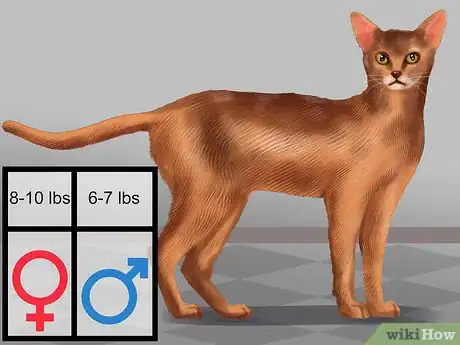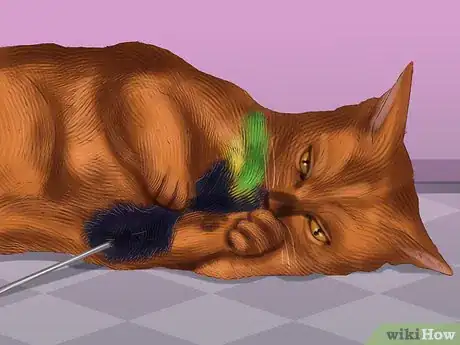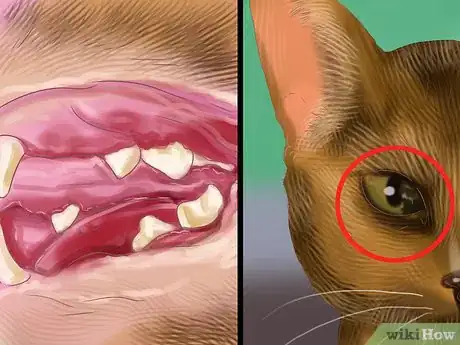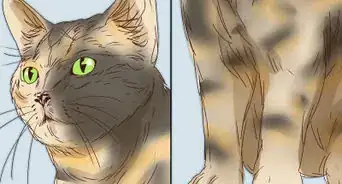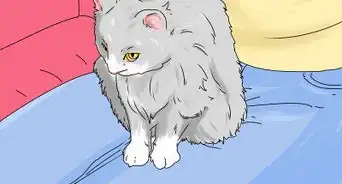This article was co-authored by Melissa Nelson, DVM, PhD and by wikiHow staff writer, Christopher M. Osborne, PhD. Dr. Nelson is a Veterinarian who specializes in Companion and Large Animal Medicine in Minnesota, where she has over 18 years of experience as a veterinarian in a rural clinic. She received her Doctor of Veterinary Medicine from the University of Minnesota in 1998.
This article has been viewed 37,276 times.
Whether they descend from the sacred felines of ancient Egypt (as tradition holds),[1] or originate from India or Southeast Asia (as genetic studies indicate),[2] Abyssinians are one of the oldest and most distinctive cat breeds regardless. As befitting their presumed connection to the Pharaohs, “Abys” are commonly described as “regal” and “majestic” in appearance and temperament, but they also possess a playful inquisitiveness that makes them great companion cats.
Steps
Studying the Cat’s Appearance
-
1Look for a cat with a slim, athletic body type. Abyssinians are slender and medium-sized. Their legs and tails are long, and they have a lean, muscular look, with a slight arch to the back. Their feet are oval shaped, and they seem almost to be standing on their toes at all times.[3]
- Males usually weigh 8-10 lbs. (4-5 kg), while females usually are 6-7 lbs. (3 kg).
-
2Check for unique head and facial features. The head of an Aby is shaped like a wedge with a slight break at the muzzle, but their ears are the most striking feature. They are noticeably large and triangular; they are also forward-arched and alert, as if the cat is eager to hear everything. Additionally, an Aby’s eyes are distinctly almond shaped and can be copper, hazel, green, or gold.[4]Advertisement
-
3Examine the distinctive qualities of its coat. Abyssinians are shorthaired cats. Adult Abys have soft, fine, dense fur, lying close to their body. Their fur is short and ticked — that is to say, each hair has a light base, with three of four bands of colour, growing lighter towards the tip.[5]
- Kittens are born with dark coats, but these lighten as they grow older.
- These cats can also have light, faded blackish stripes around the face.
-
4Look at the coat colour. The most common Abyssinian coat colour is ruddy, a warm, deep reddish brown. The ticking is black. Another common coat colour is chocolate; this is light brown. Sorrel, also known as red or cinnamon, is a light coppery base with chocolate brown ticking.
- The officially recognized breed colours include ruddy, chocolate, cinnamon, blue, lilac, and fawn. There is also a “silver” variation for each colour, with this lighter colour appearing closest to the skin.[6]
Observing Its Personality
-
1Notice the Aby’s intelligence. This breed is known for its insatiable curiosity and quick mind. An Aby will likely explore every nook and cranny of your home, yet is lithe and graceful enough to avoid disturbing items (like breaking a glass or knocking over a vase) unintentionally.[7]
- While Abys are certainly bright enough for training, many owners feel as though they are the ones being trained by this smart and crafty, yet lovable, cat.
-
2Appreciate its playfulness. Despite their regal carriage and presumed sacred heritage, Abyssinians are actually very playful and extroverted. They love to play games and interact with their human companions, and can provide entertainment as the “star of the show” for long stretches of time.[8]
- They are very affectionate cats, but are too inquisitive and athletic to be a traditional lap-cat. Lying quietly and purring for hours on end just isn’t their thing.
-
3Take note of the cat’s sociability. Abys love their human companions, and it’s nearly impossible not to love them right back. They love attention, but aren’t bossy; they love to explore, but usually don’t cause many headaches; and they normally get along well with other people and pets.[9]
- They don’t like being left alone for long stretches. On the other side of the coin, however, they also don’t prefer being one cat in a large group — they simply don’t want to share the spotlight to that extent. One or two other companions of either sex is usually fine.
-
4Check out its perching preferences. Abys like high perches with a commanding view of the surrounding space and anything going on there. Thus, expect to find them atop bookshelves, mantles, etc. Providing safe, cat-specific perches for them is a good idea.[10]
- Abyssinians also love a good window vista. They want to see what is going on outside of their own little world as well.
Using Other Identification Methods
-
1Examine its breeding papers. Abyssinians have been extensively bred in Europe since the nineteenth century and in the United States since the 1930s, and ample documentation on the Aby’s breeding heritage should be made available by any responsible breeder. If your heart is set on acquiring a show-quality, purebred Aby, do your homework, visit potential breeders, and study the documentation provided.[11]
- A good breeder typically makes Abys available at around twelve to sixteen weeks of age, as separating the kitten from its mother earlier may lead to health risks and behavioral issues.
-
2Use DNA testing. If you have no documentation of a cat’s breeding heritage, but suspect that it’s an Aby based upon appearance and personality, genetic testing can provide further evidence. A fifteen-second cheek swab can provide you with a wealth of information regarding the genetic heritage of your cat.[12]
- As with DNA testing for humans and dogs, there are a growing number of options when it comes to finding a laboratory that does genetic testing for cats. Typical tests require you to take a mouth swab from your cat using a provided kit that you mail back to the lab.
-
3Consider potential health problems. While Abys are generally healthy cats, they do have a somewhat greater risk for certain illnesses and conditions. If your cat has one or more of the following conditions, it may be more likely (but certainly not guaranteed) that it’s an Abyssinian:[13]
- Pyruvate kinase deficiency (PKD) — an inherited anemia that can be identified through genetic testing
- Hyperthyroidism
- Retinal atrophy (i.e., eye problems)
- Kidney failure
Warnings
- Don't rely only on coat colour to identify an Abyssinian.⧼thumbs_response⧽
References
- ↑ https://pethelpful.com/cats/Different-Cat-Breeds-How-To-Identify-Pet-Cats
- ↑ http://cfa.org/Breeds/BreedsAB/Abyssinian.aspx
- ↑ http://www.tica.org/find-a-breeder/item/173-abyssinian-introduction
- ↑ http://www.tica.org/find-a-breeder/item/173-abyssinian-introduction
- ↑ http://www.tica.org/find-a-breeder/item/173-abyssinian-introduction
- ↑ http://www.tica.org/find-a-breeder/item/173-abyssinian-introduction
- ↑ http://cfa.org/Breeds/BreedsAB/Abyssinian.aspx
- ↑ http://cfa.org/Breeds/BreedsAB/Abyssinian.aspx
- ↑ http://cfa.org/Breeds/BreedsAB/Abyssinian.aspx
About This Article
To identify an Abyssinian cat, check that the cat has a slim, athletic body type and weighs 8 to 10 pounds if it's female, or 6 to 7 pounds if it's male. You should also notice a wedge-shaped head and almond-shaped eyes, which can be copper, hazel, green, or gold. Then, look at its coat to see if it is soft, fine, and dense, as well as a ruddy, warm, reddish brown in color. However, keep in mind that Abyssinians can also come in blue, lilac, fawn, chocolate, cinnamon, or silver, and may have faded blackish stripes around their faces. Additionally, consider if the cat seems social, curious, graceful, and smart, since Abyssinians tend to be much more playful than the traditional lap-cat. For more tips from our Veterinary co-author, like how to identify an Abyssinian cat using DNA testing, keep reading!
